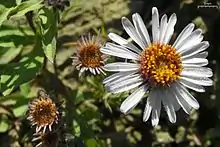Eurybia merita
Eurybia merita, commonly known as the subalpine aster or arctic aster (not to be confused with Eurybia sibirica, which shares the latter common name), is an herbaceous perennial native to northwestern North America, primarily from the Interior Mountains and Plateau system and Rocky Mountains in Canada, stretching south to Utah and extreme northern California. It is found largely in drier, open areas, generally at subalpine levels in mountains, though in more northern areas it is more common at lower elevations. It is similar in appearance to Eurybia sibirica, but their ranges only overlap near the border between the US and Canada, where E. sibirica is generally found at higher elevations than its relative. The flowers emerge in the late summer and display purple to violet ray florets and pale or creamy yellow disc florets.
| Subalpine aster | |
|---|---|
 | |
| Scientific classification | |
| Kingdom: | Plantae |
| Clade: | Tracheophytes |
| Clade: | Angiosperms |
| Clade: | Eudicots |
| Clade: | Asterids |
| Order: | Asterales |
| Family: | Asteraceae |
| Genus: | Eurybia |
| Species: | E. merita |
| Binomial name | |
| Eurybia merita (A.Nels.) G.L.Nesom | |
| Synonyms[2] | |
| |
Distribution and habitat
Eurybia merita is present in much of northwestern North America. There are also a few isolated populations in the Black Hills of South Dakota. The primary distribution is from Alberta and British Columbia in Canada, south as far as northern Utah and to Siskiyou County, California.[3][4] It is found at heights ranging from 100 up to 3200 metres (330–10670 feet) in soils that range from mesic to dry. Open woods, rocky areas, clearings and recently burnt areas constitute its primary habitat. It may also be found along sandy, rocky or gravely creek banks. Within these habitats, it is most commonly associated with subalpine meadows and Douglas fir, lodgepole pine or spruce forests. While it is generally restricted to subalpine elevations in mountains, it is found at lower elevations in the north of its range.[5]
References
- "Eurybia merita". NatureServe Explorer. NatureServe. Retrieved 2007-12-14.
- "Eurybia merita (A.Nelson) G.L.Nesom". The Global Compositae Checklist (GCC) – via The Plant List.
- "Eurybia merita". County-level distribution map from the North American Plant Atlas (NAPA). Biota of North America Program (BONAP). 2014.
- "Eurybia merita". Calflora: Information on California plants for education, research and conservation, with data contributed by public and private institutions and individuals, including the Consortium of California Herbaria. Berkeley, California: The Calflora Database – via www.calflora.org.
- Brouillet, Luc (2006). "Eurybia merita". In Flora of North America Editorial Committee (ed.). Flora of North America North of Mexico (FNA). 20. New York and Oxford – via eFloras.org, Missouri Botanical Garden, St. Louis, MO & Harvard University Herbaria, Cambridge, MA.
